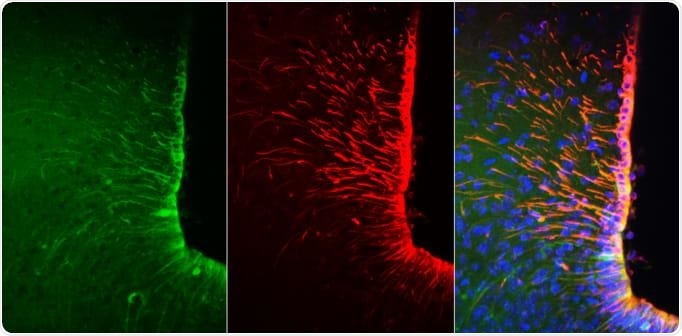Tanycytes are essentially glial cells, which interact with neurons in the brain to inform this organ about the type of food consumed by individuals.

The image shows the tanycytes expressing the light-sensitive ion channel (green), a general tanycyte marker (vimentin, red), and a stain for the cell nucleus (blue). Image Credit: University of Warwick.
Scientists from the School of Life Sciences at the University of Warwick have now discovered that selective stimulation of these tanycytes can boost appetite.
Earlier, it was discovered that tanycytes—cells found in part of the brain region that regulates energy levels—identify nutrients in food and directly inform the brain about the type of food consumed by individuals.
Tanycytes perform this role by reacting to amino acids present in foods, through the same types of receptors that perceive the flavor of amino acids (“umami” taste) present in the taste buds of the tongue.
In the study titled “Hypothalamic tanycytes generate acute hyperphagia by activation of the arcuate neuronal network” published recently in the Proceedings of the National Academy of Sciences journal on June 8th, 2020, scientists from the School of Life Sciences at the University of Warwick have described how appetite can be increased by tanycytes.
These glial cells are situated in the core of the brain region, lining one of the fluid-filled spaces called ventricles. They are capable of sensing or “tasting” the nutrients in the cerebrospinal fluid inside the ventricle.
The proportion of nutrients in this fluid differs based on the amount of food consumed. A major question in this regard is whether the tanycytes can transmit this information about nutrients to the neighboring neurons that control appetite and the amount of energy that is spent through the generation of body heat or activity.
By making tanycytes to selectively express a light-responsive ion channel, the scientists stimulated these glial cells quite specifically and demonstrated that this makes the neighboring neurons to become active. When the scientists looked closely at the identity of the activated neurons, they discovered that the tanycytes could switch on two different routes involved in the regulation of feeding.
While one route is related to an increased drive to feed, the other is related to a decreased drive to feed and higher energy expenditure. But this does not show which of these two opposed routes “wins.”
By analyzing the changes in the feeding behavior triggered by the activation of tanycytes, the scientists demonstrated that it led to a short-term increase in food intake—that is, the drive to feed more overcame the conflicting drive to feed lower and spend more energy.
Tanycytes respond to nutrients that signal the effect of feeling full, so we’d expect that when tanycytes are stimulated you would eat less, but surprisingly we found that you actually eat more. We have established a link between tanycytes and food intake, but we still don't completely understand how they will contribute to the control of body weight in the longer term.”
Nicholas Dale, Professor, School of Life Sciences, University of Warwick
“Neuronal mechanisms controlling appetite have been studied for decades. Our discovery has added an unexpected new player into this neural circuit. Our important finding is that tanycytes have an active role in increasing appetite. In the future, these cells could become potential targets to reduce or increase food intake for therapeutic purposes,” concluded Dr. Matei Bolborea, the first author of the study.
Source:
Journal reference:
Bolborea, M., et al. (2020) Hypothalamic tanycytes generate acute hyperphagia through activation of the arcuate neuronal network. Proceedings of the National Academy of Sciences. doi.org/10.1073/pnas.1919887117.